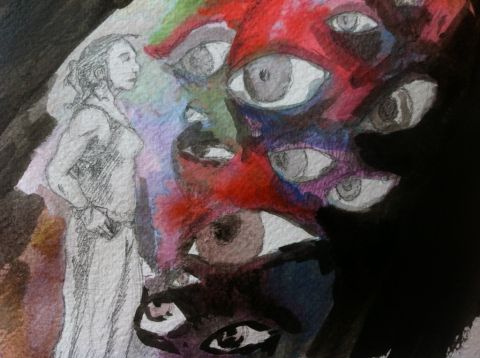#Digital partners
A-n’s recent focus on ‘digital partners’ is timely for People of the Eye. As a collective of (British) sign language poets and visual artists, we are based in various locations across the UK and may never meet. We cover quite a spectrum age-wise, with some more techno-savvy than others. Moreover, our membership consists of people who do not necessarily share the same languages, or even modality of language. The two main languages of our membership are British Sign Language (BSL) and English. At this stage we should probably take a wee diversion to explain the differences.
BSL is not a form of English. Let’s start with some basic differences; verbs in BSL do not necessarily carry time markings –although some do. Usually, distinct time markers will be used at the beginning or end of an utterance. BSL verbs are complex in other ways- they can carry information about the size, shape, and location of the subject and object, and also incorporate pronouns. Noun signs can compound (a little like German words). BSL is (arguably) a classifier language (a little like Swahili). Yet unlike Swahili, BSL is also able to exploit the dimension of space, allowing two or more distinct items of vocabulary to be simultaneously uttered. All this leads to a language that is highly morphologically productive (like Hebrew). (It has elements that carry certain meanings and these elements can be easily and freely organised to create new meanings, almost minute by minute).
Another big difference between BSL and English is that BSL has no written form.
So, in terms of collaborating we’re looking for a digital platform that can unite us across time and space, does not rely on written English, is easy to use, visually coherent and appealing, allows us to communicate through image (one of the aims of our practice), is private and will not exploit our data.
We think we might have found it.
We’re piloting the use of a platform called Voicethread. There’s a free basic package, but to use video facilities there’s a (reasonable) one-off fee. Whoever pays the fee can invite others to join, giving them various levels of access from read-only to full edit rights. The site generates an email containing a link, participants click on the link and sign in using their email address and a password of their choosing.
We have uploaded four of our poets’ works in video (these are sign poems remember). As each artist joins the platform, they upload a profile picture and can then make ‘comments’. These comments can be in a number of formats; speech (which we’re not using), written English (which we’re limiting to a maximum of 10 words per comment), video (which would allow sign language) and image.
The artists can locate themselves in the Voicethread, clustering around a particular poem to collaborate; their comments displayed in ‘speech bubbles’ that appear whenever a cursor hovers over their profile picture. Participants can play through all the comments relating to one poem in chronological order, to follow the development of a thread.
An extra advantage is that users can ‘doodle’ on any videos that are uploaded, using their cursor. The doodles are not permanently inscribed on the video, but saved as ‘comments’, re-superimposed whenever that comment is replayed (we haven’t tried this yet, so this is what we think happens).
But this is not a sales pitch for a particular product. The original uploading of the four poem videos took a very long time. Not all the artists have joined yet and some have found the simplicity of the joining procedure confusing (‘surely, I have to….’).
A further criticism would be that the ‘help’ videos are only very clear if you can hear, as the spoken guidance is fuller than the accompanying visual tutorial.
The granting of full edit rights, uploading of profile pictures and clustering around particular poems is working well so far.
One unexpected bonus is that the platform generates a ‘daily digest’ email, informing you whenever new comments have been made (which doesn’t leave your inbox groaning, like other social networking media).
We haven’t yet experimented with uploading image or doodling on the videos, but we’re on it….
